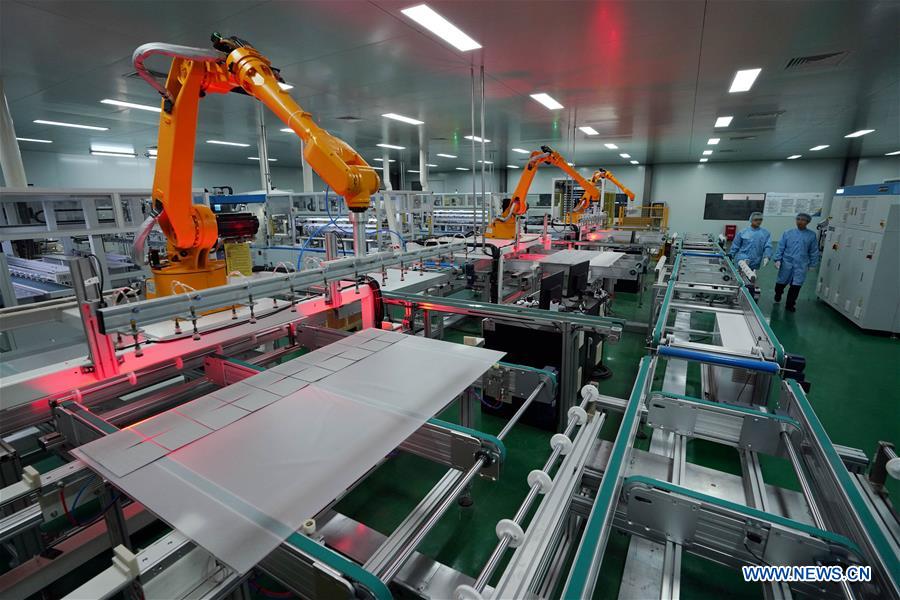
Photo taken on Dec. 11, 2018 shows the photovoltaic module production line of a company in De'an, east China's Jiangxi Province. (Xinhua/Song Zhenping)
BEIJING, April 11 (Xinhua) -- China has been lavishing money on intellectual property right (IPR) royalties with a 20-year streak of double-digit growth amid efforts to close a longstanding gap in technology and innovation.
China's external payments of IPR royalties rose 24 percent year on year in 2018 to 35.8 billion U.S. dollars, resulting in a deficit of 30.2 billion dollars, the latest data from the State Administration of Foreign Exchange (SAFE) showed.
This marked an average annual growth of 22 percent from 1997 to 2018 in the IPR royalty payments.
The fast expansion represents not only the country's strong demand for advanced technology to support its economic development and industrial upgrading, but also its enhanced IPR protection and respect for innovation, SAFE said.
STRONGER DEMAND
The payments mainly came in the computer, telecommunication, electronics, auto manufacturing, ship-building and aviation sectors, which accounted for more than 40 percent of the total. The United States, Germany and Japan were the top three exporters.
Stronger IPR protection is a requirement of foreign enterprises, and even more so of Chinese enterprises.
Although growth is shifting down a gear, China remains a dynamic market full of opportunities, striving to build an economy reliant on technology and innovation. In 2018, the contribution of technological advances to China's economic growth rose to 58.5 percent, according to this year's government work report.
In pursuing innovation-driven growth and fostering new growth drivers, China has recorded stellar growth in home-grown innovation on the back of lavish investment and better IPR protection.
China's spending on research and development increased to 1.96 trillion yuan (about 293 billion U.S. dollars) last year, about 2.18 percent of its GDP. The number of patent applications saw a year-on-year increase of 16.9 percent, amounting to 4.32 million at home and abroad.
According to the Global Innovation Index, China's global ranking in terms of innovation jumped from the 22nd in 2017 to 17th in 2018.
Qi Aimin, an IPR expert with Chongqing University, said the large deficit in IPR royalties reflected discrepancy between the country's insufficient IP supply and rapidly-expanding demand.
"The data also show Chinese firms have a rising eagerness on IPR investment and compliance in competition," Qi said. "Though the deficit is going to persist, it will narrow in the long run with China's IPR-related capabilities growing."
BRIGHTER PROSPECT
A new report by U.S. think tank Information Technology and Innovation Foundation showed China's high-tech manufacturing value-added grew from 30 percent in 2006 to 77 percent in 2016.
If this growth rate were to continue, China would exceed the United States in high-tech manufacturing value-added by 2020, according to the report.
The report said it was a misconception that China was a copier, as it could and does innovate.
In addition to fostering stronger home-grown innovation prowess, China is assuming a greater role in international cooperation in IPR-related issues.
China has been active in contributing wisdom to the development of international rules on IPR, and cooperation under the Belt and Road Initiative (BRI) is a typical example, said He Zhimin, deputy chief of the National Intellectual Property Administration.
It has established cooperation partnerships with more than 40 countries participating in the BRI and offered IPR training programs for experts and officials from nearly 30 of them, He said.
The country also advocated joint efforts with BRI-participating countries in fighting IPR infringements and creating enabling environment for IPR protection, he said.
(Video reporters: Du Yang and Liu Qu. Video editor: Zhu Cong)



